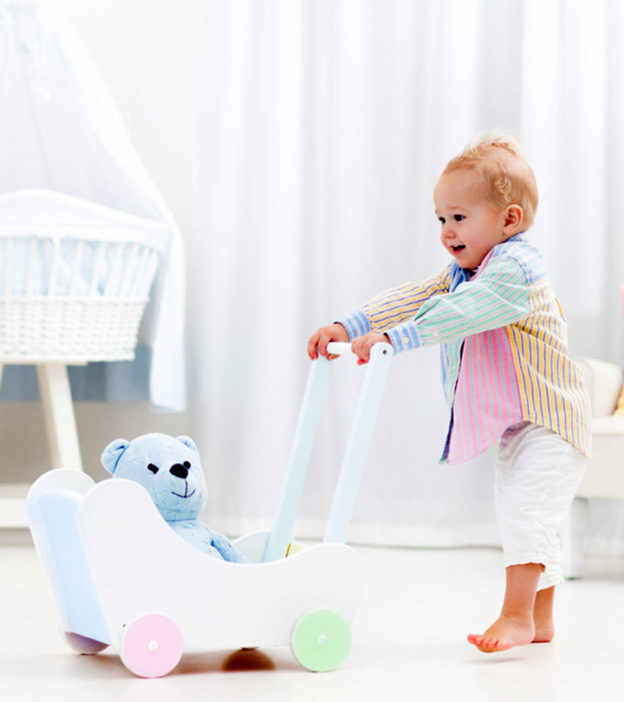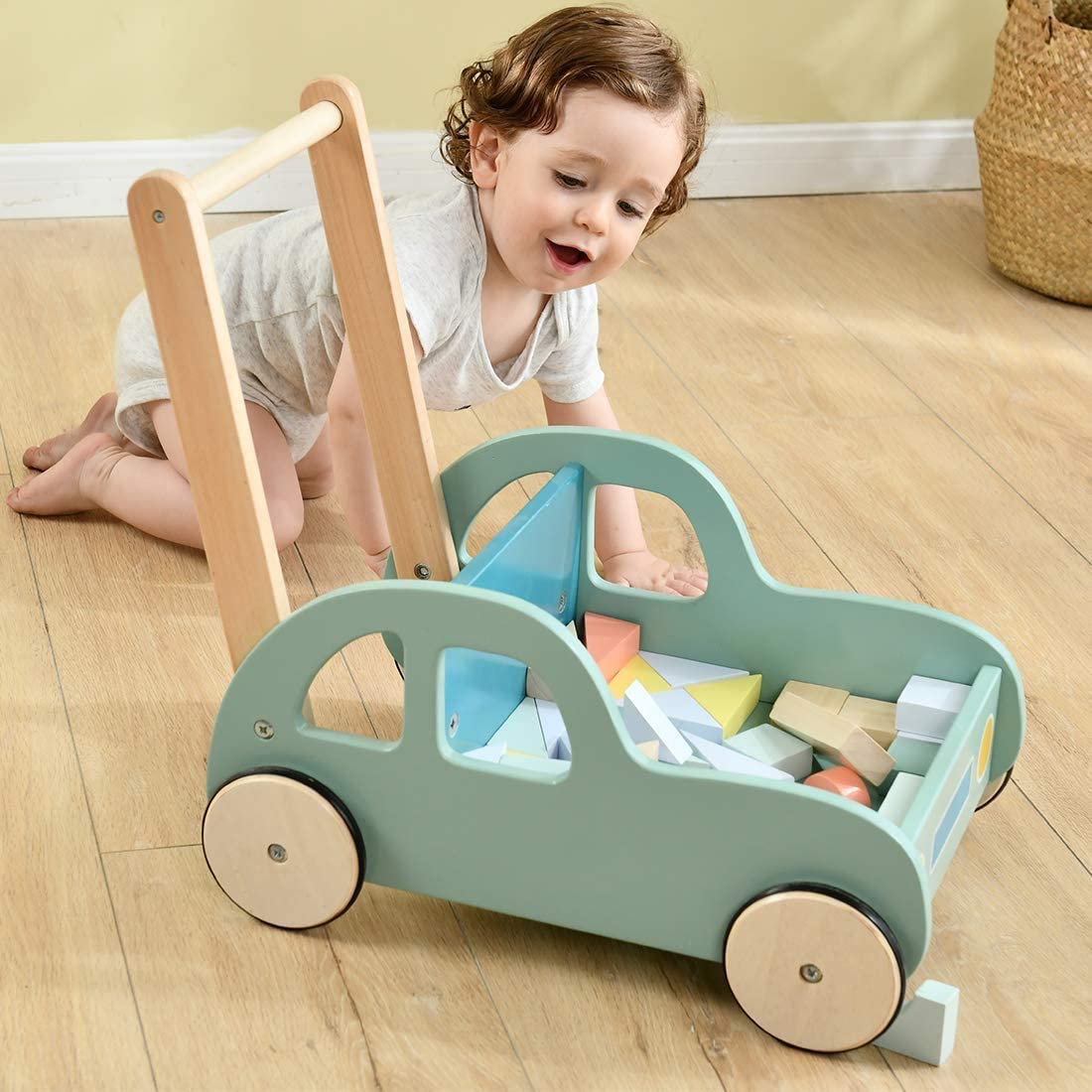You might know baby activity walkers or baby stand walkers. What’s great about baby push walkers is that they give babies the confidence to start walking independently. Often babies are really happy to cruise along furniture or lounges, but lack the confidence to move off the lounge or furniture and start to walk. But when they’re provided with the baby push walker, they have that confidence to let go of the lounge and start walking around independently. Having that time to walk around independently using a baby push walker means that they’re going to further develop their walking skills and the muscles required to walk, as well as their balancing skills in walking and in standing. In addition to increasing your baby’s confidence to walk, it also provides an opportunity to work on their fine motor skills if it has that activity panel at the front.
When you’re looking at baby push walkers, you will notice that there are two different types of baby push walkers,
- wooden push walkers
- plastic push walkers
It’s important to note that baby push walkers are different to baby walkers. I personally don’t recommend the use of baby walkers because they have been associated with risks of developmental delays and safety concerns.
When to Use Baby Push Walkers

If the push walker comes with an activity panel, and it’s detachable, you can actually place these on the ground in front of your baby during tummy time. And it will provide them with some motivation because it sings lots of songs and it lights up. So it gives them some motivation in tummy time.

And then as they learn to sit up, you can place it back into the walker. And then when they’re sitting, they’re starting to interact with this activity board while sitting. If you have a wooden one, then you would just do it sitting and have your baby sitting in front of it and interacting with it. But you want to make sure that the activity panel is in the front of the walker, not at the rear, because that makes it a bit difficult to reach for the little one.
Now, your baby will start to use the push walker as an actual push walker to help them walk around independently, when they’re able to cruise along furniture and start to stand independently for a short period of time. So this generally happens at around nine to 12 months of age.
Plastic Push Walker
There are two different types of plastic push walker
- The first one is a plastic push walker which has an activity panel in the front.
- And the second one is a plastic push walker which is a 3 in 1. So it has that activity panel in the front, it acts as a baby push walker, and it also has the ability to convert into a stationary play set table for your little one to use.
Pros of plastic push walkers
- They are extremely cheap and lightweight. And because they’re so lightweight, your baby’s going to be easily able to negotiate corners and turn around, which is really important when they’re using it to walk around.
- They also have that activity panel at the front which is often able to be removed and placed on the floor for tummy time and when they’re sitting.
- And that activity panel has lots of different music and lots of different noises it makes, such as animal noises, and it also lights up and your baby can interact with it to develop their fine motor skills.
- Baby push walkers that are plastic also have the ability to adjust the speed of the wheel. So they generally have two different settings. When your baby’s first learning to walk, you put it on the lowest setting, which makes it harder to push. So it’s not going to roll away on them as easily.
- Some models have foldable legs, which means that it takes up less space when you’re trying to store it. And it’s also easily transportable.
- And the added benefit is that some models have inbuilt motion sensors. So when your baby starts walking and starts to play music, it lights up to provide some motivation for your little one.
Cons of plastic push walkers
- Because they are so lightweight, they do tend to run away on little ones when they’re first learning to pull themselves up from the ground into standing. So when they do that and they need a lot of support to get up into standing, they generally tip the walker over. So you do need to be there to support your baby when they’re doing that movement and getting stronger in that position.
- And the other thing is because it’s so lightweight, and if it doesn’t have that ability to change the speed of the wheels, the wheel speed can just peak up. And then the walker just rolls away from your little one and they will fall over.
- Also, there are some models that can be converted from a push walker to an activity table. Those tables are really unsteady because again, they’re so lightweight. So your baby needs to be really confident in standing, and they’re not needing to get support from that table to maintain that position. If they are, they’re just going to tip that table right over.
- Because plastic push walkers are so lightweight, and they have that risk of running away on little kids when they’re pushing it and also pulling themselves up into tipping over.
- They are generally better to be used on carpeted flooring rather than tiles or wooden flooring just because it gets more traction when they’re on carpeted flooring. And then they’re less likely to run away on your little one, and also tip. But in saying that once your little one is able to walk around quite well using the push walker and not needing a lot of support, you’re more than able to move the baby onto using the push walker when they’re on tiles and on floorboards.

If you are looking at purchasing a plastic push walker for your little one, I find the Vtech sit-to-stand push walker the best. And that is because it has that adjustable wheel speed. It also has the ability to fold the legs, and it’s relatively cheap. In Australia you can buy it for $65, in the US it’s around $45.
Wooden push walkers
There are two different types of wooden push walkers.
- Basic wooden push walkers which are generally really quite simple. And they generally come with blocks in the front that you would use at another time.
- Heavy wooden push walkers with activity panels. There are some more complex push walkers which have an activity panel on it. So it’s at the front or at the back. The front ones are better because it’s easy for the little one to reach when they’re sitting.

Pros of wooden push walkers
- With the light ones, they are easy for your baby to move around and negotiate corners.
- Wooden push walkers with the tray are extremely light. But really all baby walkers are likely to tip when your baby’s first learning to do a sit to stand, so they pull themselves up from the floor into standing. But because it is lightweight, but it has that tray, I generally just put a weight in the front. So I’ve used two kilo rice bags or a kilo rice bag to make it a bit more stable in the beginning stages when your little one’s first learning to walk. But as they get more confident, you can just remove the weight at the front, and then they’ll start to put in teddies or blocks or cars or dinosaurs and move them all around the house.
- The walkers with the trays are significantly cheaper than the heavier wooden walkers. So the ones with the trays, in Australia you can buy from around $60 and in the US it’s around $45. Whereas the heavier ones you can purchase in Australia for around $100, and in the US it’s around $65.
- Wooden push walkers also tend to have rubber trimmed wheels, which will protect your flooring.
Cons of wooden push walkers
- They tend to be a lot heavier and really difficult to move and negotiate corners.
- There is a risk that they might run out from underneath your baby or tip
- If you’ve got those really heavy ones, they can only go in a straight line and then your baby’s not able to turn them. So you’re going to have to pick them up and turn them around. And if you’ve got a really compact house with not much space, then that’s probably not an ideal walker for your little one to use, whereas with the smaller ones, your baby’s going to be able to easily move around the house and negotiate those corners.
- They are not able to be collapsed or folded when they’re not in use for storage. So that might take up a bit more space.

If you do want to buy a wooden push walker, I would lean towards buying the more basic push walkers that just come with the block, other than the push walkers that have that activity panel. Because the main reason for using a push walker is to work on their walking skills. So if they can’t push it or turn it around corners, they’re going to get extremely frustrated. Whereas the lighter weight one, which is that really simple, basic wooden push walkers that come with blocks, they’re able to move freely around the house. And you can just put a weight in it initially so it doesn’t roll away on your little one when they’re first learning to walk.
So those are the two different types of push walkers you can get. Personally, I prefer the wooden push walkers with the simple blocks in it. And that is because I think that it has longevity and it can last for a number of years, where Vtech was suitable for the first two years, and then they’re no longer interested in it.

